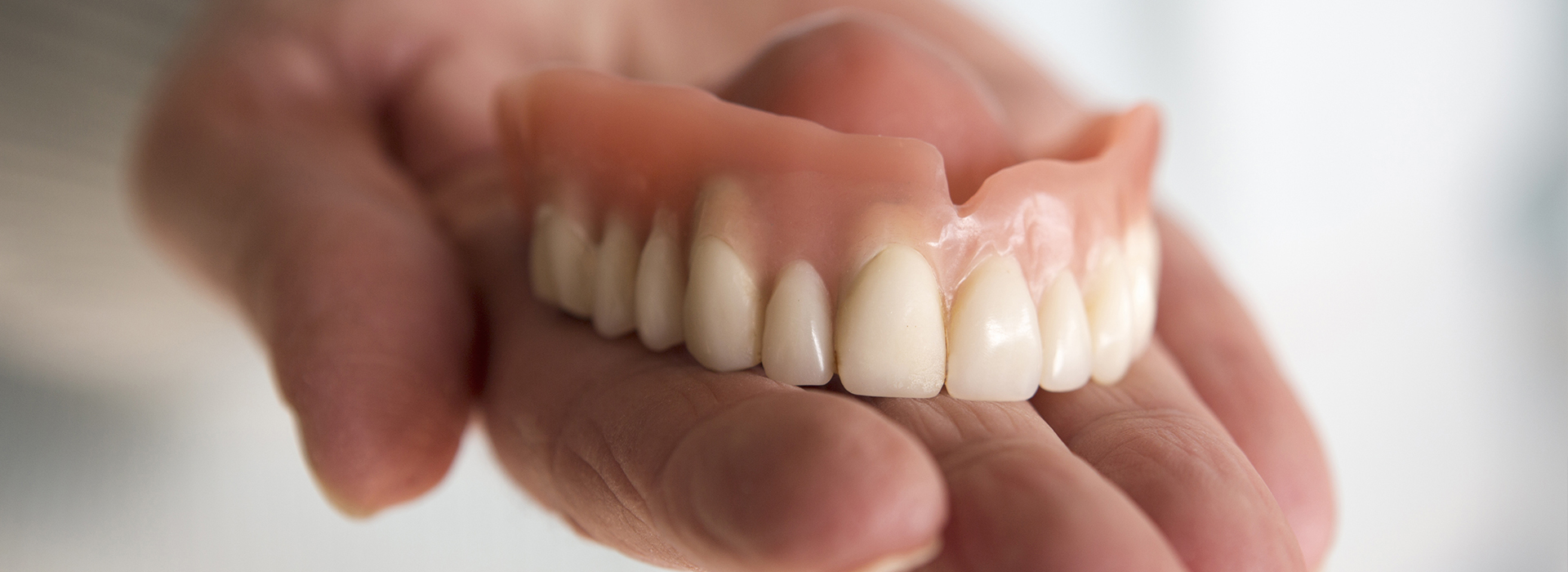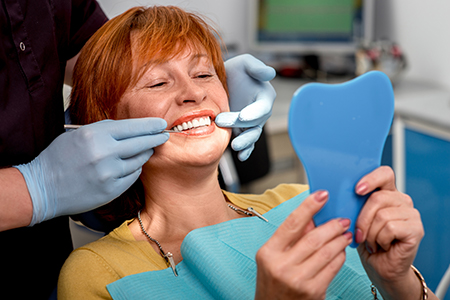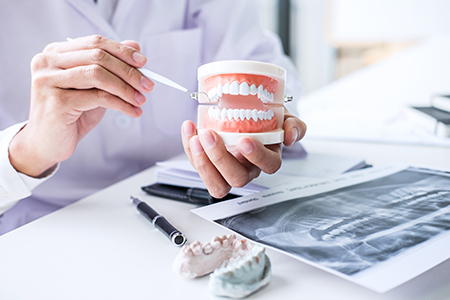
Thanks to advances in dental materials and laboratory techniques, replacing missing teeth today delivers more natural form and function than ever before. Although modern dental implants and fixed bridges provide long-lasting options for many patients, removable dentures remain a reliable, versatile solution for restoring a complete, confident smile.
At the office of Value Dental Center, we take a careful, patient-centered approach to denture care. Every prosthesis we fabricate is planned with attention to fit, facial support, and long-term oral health so patients can speak, eat, and smile with comfort and confidence.
Our goal is to present clear, practical information so you can weigh your options with confidence. The following sections explain how dentures work, the types available, how they’re made, and what to expect as you adapt to your new prosthesis.
Losing teeth affects more than aesthetics. Gaps in the dentition alter the way your bite distributes force, which can accelerate wear on remaining teeth and increase the risk of shifting or tipping. These changes may lead to uneven chewing, jaw discomfort, and a higher likelihood of further tooth loss if left unaddressed.
Beyond functional issues, missing teeth influence the underlying bone. When a tooth is absent, the local jawbone gradually remodels and can shrink over time — a process that changes facial contours and the fit of future restorations. Replacing missing teeth in a timely way helps preserve oral structure and reduces long-term complications.
There are also practical consequences: speech can be altered, and everyday activities like biting into certain foods may become awkward or uncomfortable. Removable dentures are designed to restore both the appearance and the daily function of a full set of teeth for many patients, improving nutrition, communication, and confidence.
Dentures are prosthetic devices that sit on the gums and replace missing teeth with lifelike artificial teeth set into a supportive base. Today’s materials allow for realistic tooth anatomy and gum-colored bases that blend with natural tissues. Careful design ensures the denture supports facial contours and distributes chewing forces safely across the mouth.
One of the practical advantages of removable dentures is their accessibility for cleaning. Because they can be taken out, patients can thoroughly clean both the prosthesis and the mouth’s soft tissues and remaining teeth, helping to control plaque and maintain oral health. This removability also makes adjustments and repairs more straightforward when needed.
While fixed options such as bridges and implants provide distinct benefits for certain candidates, many people choose removable dentures for their flexibility, fewer surgical requirements, and ability to restore multiple missing teeth at once. Your clinician will describe the right approach based on your oral health, anatomy, and personal needs.

Selecting the most appropriate denture begins with a careful evaluation of the teeth that remain, the condition of the gums and bone, and your daily habits and expectations. The decision is clinical as much as it is personal — what works best for one patient may not be ideal for another.
At the office of Value Dental Center, we review all factors and explain the options in straightforward terms so patients can make informed decisions. Below are the primary denture categories and the common variations within them.
Two broad classes of removable dentures meet most needs: full (complete) dentures, which replace all teeth on an arch, and partial dentures, which fill in one or more gaps while integrating with the remaining natural teeth. Each class has subtypes that address different clinical scenarios and stability requirements.
Complete dentures replace all teeth in the upper arch, lower arch, or both. Their design focuses on achieving a secure fit against the ridge of the jaw while restoring appearance and chewing ability. A well-made complete denture supports the lips and cheeks to help maintain a natural facial profile.
A conventional full denture is created and fitted after the extraction sites have healed. Waiting for complete healing tends to give the most predictable fit and comfort because the tissues have stabilized before impressions are taken.
Immediate denture
An immediate denture is placed the same day teeth are removed so the patient never goes without teeth during healing. It’s a practical choice for many, though the fit will usually require relines or adjustments as the tissues remodel during recovery.
Overdenture
An overdenture gains extra support from remaining tooth roots or specially placed attachments. By preserving certain natural teeth or tooth roots under the denture, an overdenture can improve stability and preserve bone in targeted areas.
Implant-supported dentures
Implant-supported options connect a removable or fixed prosthesis to strategically placed implants. This approach substantially increases retention and chewing efficiency and can be adapted to meet a wide range of functional and aesthetic goals.
Partial dentures are designed to mesh with healthy remaining teeth, using clasps or precision attachments to stay secure. They restore missing tooth surfaces and help maintain the proper alignment of the natural dentition by preventing neighboring teeth from drifting.
Modern partials can be crafted from several materials — from lightweight flexible resins to metal frameworks finished with gum-colored acrylic — allowing the design to be tailored to comfort, durability, and visibility concerns.
A thoughtfully designed partial denture not only fills aesthetic gaps but also plays a preventive role by stabilizing the bite and protecting the long-term health of the adjacent teeth.

Creating a successful denture requires a stepwise, coordinated process. It begins with a thorough medical and dental review, clinical measurements, and often diagnostic imaging to evaluate bone levels and oral anatomy. These steps help ensure the prosthesis will fit, function, and support facial balance.
Impressions capture the precise shape of the gums and ridge, which laboratory technicians use to fabricate frameworks and teeth that match the patient’s proportions. Careful selection of tooth shape and shade helps the final result look natural and harmonize with the face.
Trial fittings allow adjustments to bite, tooth position, and aesthetics before the final prosthesis is completed. Attention to occlusion (how the teeth come together) and soft-tissue comfort during these try-ins is essential to reducing sore spots and ensuring effective chewing mechanics.
When necessary, pre-prosthetic procedures — such as smoothing bony ridges or extracting unsalvageable teeth — are coordinated so the denture can sit on a healthy foundation. For patients considering implant attachments, collaboration with surgical and restorative teams ensures the final prosthesis meets both surgical and prosthetic requirements.

Adapting to a new denture is a gradual process. Early on, it’s common to notice increased saliva, mild soreness in specific areas, and slight changes in speech. These reactions typically subside as the mouth adjusts; practicing speech and starting with soft foods can speed adaptation.
Speaking and eating with a denture become easier with time. Begin with small, soft bites and chew on both sides to distribute pressure evenly. Avoid hard or sticky foods until you feel fully comfortable, and be patient — most patients regain most function within a few weeks.
Proper daily care preserves both the denture and oral tissues. Rinse and brush the prosthesis after meals, soak it overnight as directed, and continue to brush any remaining natural teeth and gums to reduce plaque and irritation. Removing the denture at bedtime gives the gums a restorative break and supports tissue health.
When adjustments help
Minor sore spots are common during the first few appointments. Timely adjustments in the office prevent ongoing irritation and improve fit.
Stability options
Some dentures gain extra retention from adhesives, attachments, or implants. Your clinician can recommend the right level of support based on oral anatomy and lifestyle.
Regular checkups and relines
As jawbone and gum contours change over time, relines or adjustments can be done to restore fit and comfort. Routine visits also allow us to monitor oral health and the condition of both the denture and any remaining teeth.
We are committed to guiding patients through every stage of denture treatment — from the initial consultation to follow-up care. If you have questions about whether a denture is the right option for you or want to learn more about the process, please contact our office for more information.
Today, it’s easier than ever to replace missing teeth and achieve natural-looking, durable, and long-lasting results! Depending on a patient’s dental needs, lifestyle, expectations of care, and budget, choices can include conventional fixed bridgework, dental implants, or removable partial and complete dentures. At the office of Value Dental Center, we’ll discuss all your options in care and answer all your questions as you choose the solution that’s right for you.
With advances in dental materials and technology, today’s dentures are more comfortable and realistic-looking than ever before.
Whether you wear partial or complete dentures, it’s essential to see the dentist for routine care. Besides checking the fit and condition of your dentures and making any necessary adjustments, you’ll also receive a comprehensive exam to check on the health of any remaining teeth as well as the soft and hard tissues in and around the oral cavity.
A same-day denture offers an accelerated design and fabrication process that allows a patient to go from impression taking to denture insertion in a single day.
For patients who don’t want to wait after having teeth extracted, an immediate denture can be inserted the same day your teeth are removed. Sometime later you may need the denture relined to address any changes in its fit once the extraction sites have completely healed.
While no one wants to drop or break a partial or complete denture, accidents do happen. The good news is that in some cases, your partial or complete denture is reparable. It all depends on the extent of the damage. Don’t hesitate to contact our office if you’ve broken or damaged your denture. We’re happy to help.
The simple act of taking your partial denture in and out can cause certain types of metal clasps to loosen over time. When you come in for your checkup visit or contact our office for an adjustment, we’ll assess the fit of your partial and tighten the clasps for improved stability and comfort.
While rebuilding a complete smile is a worthwhile investment, our office is sensitive to the costs involved in dental care. We customize care and will discuss which treatment options address your needs, lifestyle, and budget. How much a new denture will cost depends on the type of the prosthesis, its design, and the materials used to fabricate the supportive base, teeth, and clasps or precision attachments. Dentures that include the placement of dental implants for added retention and stability typically involve additional costs.
If you have dental insurance, your coverage may include a new or replacement set of dentures. Our staff is happy to review your coverage with you to ensure you are maximizing your insurance benefits while minimizing any out of pocket expenses.
At the office of Value Dental Center, we provide an extensive range of dental services, including the latest and most effective methods to help patients with missing teeth rebuild complete and beautiful smiles. As skilled and experienced professionals, we recognize that every patient is different, and every smile is unique. We’re passionate about what we do and take great pride in providing personalized treatment plans while treating our patients as valued partners in care.
Dentures are removable prosthetic appliances that replace missing natural teeth and the surrounding gum tissue. They consist of artificial teeth set into a supportive base that rests on the gums and underlying bone. Dentures restore chewing function, help maintain facial contours, and improve the appearance of the smile.
Properly made dentures distribute bite forces across the gums and remaining teeth when present, allowing patients to eat and speak more comfortably. They are designed to be removable for daily cleaning and overnight rest of the tissues. With routine care and periodic professional assessment, dentures can provide many years of functional benefit.
The two primary categories of removable dentures are full (complete) dentures and partial dentures. Full dentures replace all the teeth in the upper or lower arch, while partial dentures fill gaps when some natural teeth remain and typically use clasps or precision attachments for retention. There are also variations such as immediate dentures placed at the time of extractions, overdentures that gain additional support from remaining teeth or attachments, and implant-supported dentures that secure to dental implants for greater stability.
The choice of design depends on the number of missing teeth, the condition of remaining teeth and bone, and the patient’s functional and aesthetic goals. Advances in materials allow for lightweight, natural-looking teeth and comfortable base materials. A comprehensive evaluation will determine which type of denture best meets an individual’s needs.
Many adults who have lost multiple teeth or who require full-arch replacement are candidates for dentures, but candidacy depends on oral health, bone support, and overall medical history. A clinical exam, dental X-rays, and a review of existing teeth and gum health help determine whether a full or partial denture is appropriate or whether pre-prosthetic treatment is needed. Factors such as uncontrolled gum disease, severe bone loss, or certain medical conditions may require additional treatment prior to denture fabrication.
During your consultation at Value Dental Center, the clinician will explain available options, including when adjunctive measures such as tooth extractions, periodontal therapy, or implant placement may improve outcomes. The goal is to select an approach that balances function, comfort, and long-term oral health. Individualized planning ensures the prosthesis supports chewing, speech, and facial aesthetics.
The denture process begins with a thorough examination and diagnostic records, including impressions and bite registrations to capture jaw relationships. These records guide the lab fabrication of the denture base and teeth, followed by try-in appointments to verify fit, tooth position, and appearance prior to final processing. Multiple steps may be required to refine occlusion and ensure the appliance fits comfortably without causing sore spots.
Once the final denture is delivered, clinicians assess function and make any necessary adjustments to relieve pressure points and optimize bite. Patients are given instructions on wearing and care, and follow-up visits are scheduled to address adaptation issues and monitor tissue changes. Ongoing maintenance, including relines or adjustments, helps preserve fit as the mouth remodels over time.
Daily cleaning is essential to prevent staining, plaque buildup, and odor on removable dentures. Rinse dentures after eating to remove debris, brush them gently each day with a nonabrasive denture brush and mild cleanser, and soak them overnight in plain water or a recommended soaking solution to maintain shape and hygiene. Avoid using regular toothpaste or abrasive cleaners that can scratch denture surfaces.
It is also important to maintain oral hygiene for any remaining teeth and soft tissues by brushing gums, tongue, and palate and using appropriate interdental cleaning where teeth remain. Remove dentures at night to give gums a rest and reduce the risk of irritation and tissue inflammation. Regular dental checkups allow the clinician to evaluate the prosthesis and the health of oral tissues.
Adjusting to new dentures typically involves a short adaptation period for speech, chewing, and oral comfort. Many patients experience increased saliva flow, mild soreness, and minor difficulties with certain sounds or foods during the first days to weeks. Practicing speaking aloud, starting with soft foods, and taking small bites can speed adaptation and build confidence with the prosthesis.
Minor adjustments are common after delivery and are addressed quickly at follow-up visits to eliminate sore spots and improve function. If persistent discomfort, difficulty with retention, or ongoing speech problems occur, further evaluation can identify solutions such as relines, adjustments, or alternative retention methods like implant support. Your dentist will guide you through each step until the denture functions comfortably.
Yes, many dentures can be stabilized or supported by dental implants to improve retention, chewing efficiency, and comfort. Implant-supported overdentures attach to a small number of strategically placed implants using attachments that clip or snap into the prosthesis, which greatly reduces movement and provides a more secure fit. This option is often recommended for lower dentures, where conventional prostheses may have less stability.
Implant-retained solutions require a clinical evaluation to confirm sufficient bone and overall health for implant placement and healing. Treatment planning includes imaging and discussion of the surgical and restorative phases, after which the overdenture is fabricated to engage the implant attachments for long-term function. Implant support can also help slow bone resorption by transferring some chewing forces to the underlying jawbone.
Follow-up visits are important soon after denture delivery to check fit, relieve pressure points, and confirm proper function. As the gums and jawbone remodel over months and years, the denture base may cease to fit precisely, and a reline or adjustment becomes necessary to restore intimate contact with the tissues. Routine annual checkups allow the dentist to evaluate the prosthesis, screen for oral health issues, and recommend appropriate maintenance.
Signs that you may need an earlier visit include new soreness, persistent rubbing, difficulty chewing, or changes in speech or occlusion. For implant-supported dentures, periodic maintenance of attachments and implant health is also required to preserve performance. Prompt attention to any concerns prevents larger problems and extends the useful life of the prosthesis.
Dentures can alter mouth space and the way the tongue, lips, and palate interact, which may temporarily affect speech production. Common issues include slight lisping or difficulty with sibilant sounds while you adapt to the new contours. Regular practice by reading aloud, speaking slowly, and repeating challenging words helps retrain muscle coordination and improves clarity over time.
Properly contoured teeth and a well-fitted base reduce speech difficulties, and adjustments can be made if persistent problems occur. If you experience long-term speech changes, discuss them with your clinician who can evaluate fit and make refinements. With a correct fit and practice, most patients regain natural speech function within a few weeks.
Maintaining oral health with dentures involves both prosthesis care and ongoing attention to the soft tissues and any remaining natural teeth. Brush any retained teeth and gums twice daily, use antimicrobial rinses if recommended, and keep dentures clean to reduce the risk of infections such as denture stomatitis. Avoid tobacco use and limit habits that can damage the prosthesis or irritate tissues.
Regular dental exams are essential to screen for oral cancer, monitor tissue health, and assess remaining dentition and bone levels. If you notice changes in fit, persistent pain, sores, or unusual tissue appearance, contact your dental provider promptly for evaluation. Proactive care preserves oral health and supports the long-term success of your dentures.
Quick Links